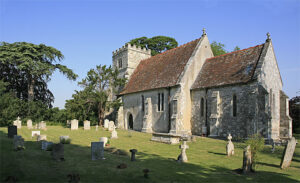This fine Early English parish church is included in the list of buildings of special architectural interest. It has a nave and chancel only and a solid square tower built of stone and flint in a chequerwork design.
The list of Rectors, extracted from the Diocesan Register, dates back to 1297 but there may have been many before this time. Of the original church building only a few fragments remain, two carved stone heads can be seen at ground level on either side of the porch. It is not known just when the present church was built but there are initials scratched in the stonework, the earliest of which have the year 1620 beneath them. The chancel was completely rebuilt in the 1870s. When this was done a Norman window was discovered and glazed.
The Odstock Register dates from 1538. One item of historical interest is a memorandum made by the Rector in 1644 at the time of the Great Civil War. It states that Royalist troops quartered in Odstock deface the Register by scribbling on the pages.
The treasure of the church is the Elizabethan pulpit which has panels carved with Tudor roses and marigolds and which bears the date 1580. The pulpit stood originally in the Chapel of the Manor House with a sounding board above it. Wooden scrolls round the board carried the legend, “God bless and save our loyall Queen, the lyke on earth was never seen”. The scrolls with the newly restored lettering are now at the base of the pulpit. On the south wall of the nave, near the organ, is a tomb in a canopied recess. On it is engraved a gowned figure of indeterminate sex but there is no record of whose tomb it is. Some believe that the founder of the church lies here but this cannot be proved.
Also, behind the organ, there is a piscina in the wall which suggests that at one time the Altar stood against an eastern end of the nave prior to addition of the chancel.
The eighteenth-century heraldic monument in the southwest corner of the nave was erected by Sir John Webb, owner at the time of the Manor House, in memory of his four children who all died in infancy.
Not long after the property was acquired by the Earl of Radnor and it was he who presented the pulpit to the church. He also built a gallery in the tower which once house an organ.
There are three bells in the tower which can be chimed though not properly rung because of the deterioration of the wooden frame in which they are hung.
The Churchyard holds a grave of interest – that of an old gipsy named Joshua Scamp. He was hanged in Salisbury having been found guilty of stealing a horse, though in actual fact it was taken by his worthless son-in-law. For the sake of his daughter, Joshua accepted the blame and went to the scaffold. His grave has a rambler rose growing by the headstone.
More information can be found on the Benefice website www.chalkevalleychurches.org

